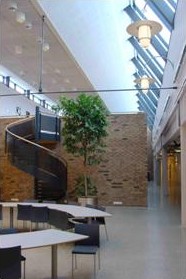
The renovation of Borgen Community Centre has been completed. The goal was to reduce energy consumption by 50% or better. The goal has been reached by a number if innovative low-energy building technologies covering additional insulation, a natural hybrid ventilation system with inlet towers and underground culverts and heat pump heating.
The objectives of the renovation project:
The main objective was to turn the building into a modern local community centre with emphasis on environment, resources and indoor climate. The building envelope was generally in a poor condition and in need of a comprehensive retrofit.
Building constructions:
Roof construction was strengthened and insulation was increased to an average thickness of 300 mm, which resulted in a U-value of 0,13 W/m2K. Walls were completely rebuilt with 200 mm insulation. This gives a U-value of 0.2 W/m2K that is within Norwegian requirements.
New windows have wooden frames with outside aluminum cladding. Glass is high quality double-glazing with low emissive coating. Theoretical U-value is 1,1 W/m2K, which is well below the national requirements of 1,6.
Existing floor slabs were given a new 100 mm insulation layer underneath a new 100 mm concrete floor slab. Some areas were covered with oak floorboards, but the greater part was grated and waxed to give a robust surface with high thermal capacity. The insulation layer was also used to lay new water pipes and electric cables.
Heating:
To optimize the use of renewable energy, a geothermal heat pump was chosen. Heat is pumped from the ground from 44 150 m deep energy wells. During the summer it could provide cooling by pumping excess heat back into the ground and thus “recharging” the wells. The heat pump produces low temperature hot water, 45 to 50˚ C. Heat is distributed by water to radiators under the windows. It is also used to preheat DHW to about 40˚C and the temperature is then lifted to 75˚C by electric heating.
Two oil boilers are installed as a backup system, and they have sufficient capacity to heat the building and supply hot water if the heat pump is out of function. The heat pump is dimensioned for 60% of total needs. Under normal conditions this is enough and the oil burners will kick in only a few days during the winter. The energy plant also supplies hot water for heating to the nearby Vardåsen church.
Ventilation:
The main ventilation is based on a natural hybrid system with inlet towers and underground culverts for fresh air supply. Since we had an existing building, culverts had to be built outside along the foundations. From the culvert air is let into the room through specially designed grids that allow people to stay close without feeling a draught Air flow through each room is regulated by electrically operated windows in the wall towards the central area. The opening (and the air flow) is regulated by temperature and CO2 sensors in each room and thereby adjusted to the actual needs.
Exhaust towers located over the central area in each base, are equipped with fans that are activated when natural driving forces are insufficient. Heat recovery systems supply heat to the preheating units in the culverts. To benefit from wind forces a special shutter system was developed to ensure that wind always helps evacuate the air and never build up a counter pressure that could reduce or stop the natural airflow.
Lighting:
The shape of the building made it necessary to improve daylight conditions. The large skylight is facing north at an angle that does not let direct sunlight and heat into the long central section of the building, but greatly increases the level of daylight. The narrow window facing south also contributes without letting in too much heat. The raised windows in the central section of the base areas do the same, but shutters had to be used to prevent unwanted heat.
To optimize the effect of daylight, all artificial lights are adjustable and regulated by light sensors. In addition, light is also regulated by motion sensors that will turn the light on when someone enters the room, if conditions require so. When a room is left empty, the light will automatically be turned off after a preset time lapse. The IR-sensors also serve as detectors for the burglar alarm during the night.
Energy saving:
The goal was to reduce energy consumption by 50% or better. The old building had a total energy consumption of 280 kWh/m2/a and our estimates projected a total consumption of 111 kWh/m2/a. Preliminary monitoring show that we last winter under optimal running conditions for the heat pump had a total energy consumption as low as 100 kWh/m2/a. It is fair to expect an average consumption close to our goal.
Solar thermal collectors:
The development of a new type solar collector, based on a glass construction and liquid heat medium, has moved from the initial face to constructive planning. A project group is planning to install a prototype at Borgen. The idea is that collectors can become building integrated elements in roof or wall constructions.
Preliminary studies of potential energy gain under different solar conditions and different locations indicate temperatures from approximately 22 to 43°C for the southern Norway region. Naturally, results improve as one moves south, but the low sun in the winter also gives good results for vertical collectors. The project group hopes to obtain higher temperatures with improved glass constructions and better heat medium. Production of domestic hot water will require a heat pump to raise the temperature to a level where legionella problems are avoided. This may not be a problem with closed circuits for room heating only.
Plans are to have design ready for a prototype in February 2006 and the first prototype ready for installation at Borgen by mid April. The effects will be monitored during a test period of one year and the results will be used in the development of the final production unit.
ACC windows:
The same group is also engaged in the development of a wooden window with a sash that may be turned 180 degrees in the frame. The sealed glass unit has one solar absorbing glass and one glass with low emissive coating. This will give increased solar gains during the heating season with the solar absorbing glass facing inwards, and reduction of unwanted heat during the summer when the absorbing glass is facing outwards.
Preliminary designs for window frames and sashes have been completed. A prototype for the special hinges is produced and details concerning the wind tight sealing have been designed. A prototype of the ACC window will hopefully be ready for installation along with the solar collector next spring.
|




